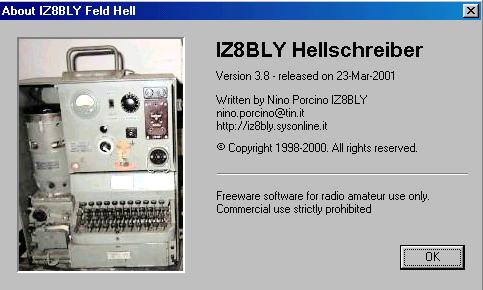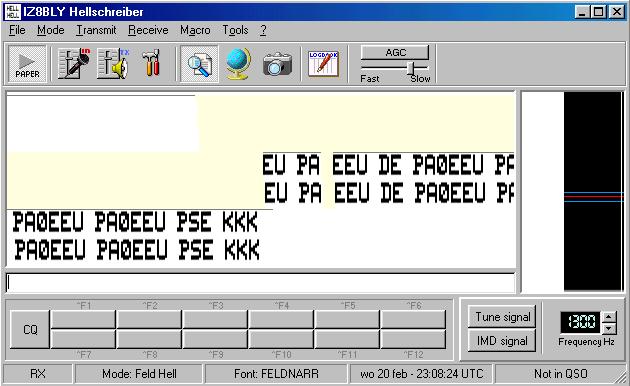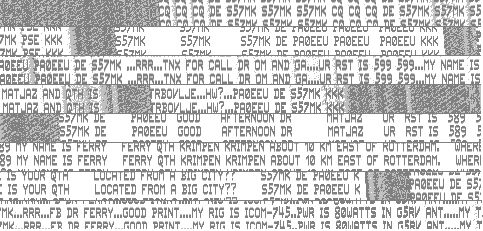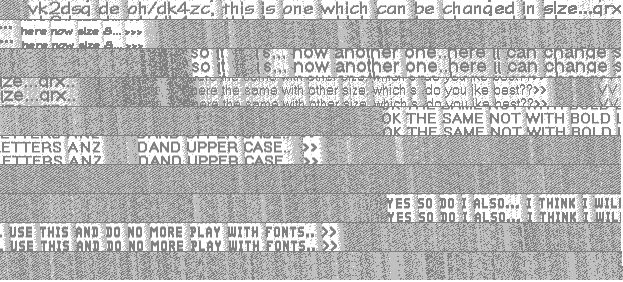
![]()
Hellschreiber
Fuzzy modes are analogue human readable modes with unusual characteristics, and some very real benefits. Hellschreiber, and related modes are analogue, human readable, uncoded, direct viewing or printing modes, and so are truly fuzzy modes. Another example of a mode that is considered to be a fuzzy mode - don't be shocked - is Morse. It is not coded, rather it is a natural language. The signal is read from the receiver without any change to time of arrival of data or content of data. Computer reception of Morse, which requires electronic decisions, must always perform worse than a human expert. If you can handle Morse and have tried out one or more of the available Morse decoders you know that this is true.
Most digital communications modes are intended to be read by a machine, a either mechanical or electronic. Analogue modes are generally intended for direct human interaction. There are however a very few machine generating communication modes intended to be human readable. These are Morse, FAX, SSTV, Feld-Hell and MT-Hell. Not all of these modes are truly fuzzy modes. Hellschreiber describes a method of sending text by radio or telephone line that involves dividing each text character into little pieces and sending them digitally. As the inventor's name is Hell, Hellschreiber can be translated from German as Hell's Writer. Another translation could be "bright writing". Anyway Rudolf Hell patented Hellschreiber in 1929. The first major application of Hellschreiber was transmission of text for newspapers by telephone line in the years before World War II. Hell's invention was thus the world's first practical facsimile machine. During the second World War the Germans did think for some time that it would be very difficult to crack the Hellschreiber 'code' and seemed to have used plain text instead of encrypted text over radio. That was not so smart as it turned out later that it had been cracked already in a very early stage by the British. A portable war time machine (Feld Hell = Field Hell) was produced and intended for use with field telephones or radio equipment. Later also Hell page printers were developed.
The traditional method of sending Hellschreiber is to key a Morse transmitter ON for every black spot in a text character, and OFF for every white spot. The same parts of each character are sent in different time slots. So each characters is sent twice but the second one a little bit later than the first, as can been seen from the sample 'tape'. The technique is still in use by radio amateurs over the world, still using pre-war parameters, and working world wide, and is called Feld-Hell (Field-Hell). It was widely used for field communications by the German Army. Feld-Hell offered good immunity to interference.
Feld-Hell is "quasi-synchronous" mode. It should be noted that the text is printed twice, but not transmitted twice. Hellschreiber is not a digital mode. It is therefore surprising to note that this mode is currently recognized by the ARRL DXCC Committee as RTTY, while it is not! It may well be that the name of the war time Hell machine "Feldfernschreiber" meaning "field teleprinter" confused them.
To learn more about Hellschreiber, download free software and find other Hell operators, check out the Fuzzy Modes web site at:
Operating Frequencies:
80m 3.575 (Region 1) 3.559 (Region 3)
40m 7.030 - 7.040
30m 10.135 - 10.145
20m 14.063 - 14.070 (many operators watch 14.063 MHz)
17m 18.101 - 18.107
15m 21.063 - 21.070
10m 28.063 - 28.070

This 'About' screen is from Nino Porcino's latest program Hellschreiber V3.8. You can download this freeware program from the URL as shown. The machine to the left is the original mechanical Hellschreiber. Quite a machine and if necessary usable as a boat anchor!

This is a sample of the screen. QSO samples are shown below
To meet Nino and Murray on air, try during weekends (Sat-Sun) in Feld Hell mode, on 14062.5 KHz USB around 13:00 UTC, or on MFSK week days on 18.106 MHz (idle carrier) at around 0530 or 1930 UTC.

This is the result of a Feld Hell QSO with the Hungarian amateur station HA9OA in the town of Miskolc. Lucky for me that I speak the Hungarian lingo a little bit!

Another example of a QSO with the Swedish station S57MK. I lost some of the 'long haul' pictures I am afraid...

Here the Finnish/Danish station OH/DK4ZC is experimenting with several types of font with the Australian station VK2DSQ. Possibly via a short haul path over the North Pole. With the mechanical pre-war and war Hell machines the font was fixed!